👇 Click on a date to jump to information from that time period:
Chip Shortage Update 7/19/22
More than 100,000 vehicles were cut from North American production schedules last week, the biggest weekly cuts in months.
North America’s latest chip shortage numbers reflect the impacts of semiconductor plants going offline for summer holiday breaks at plants, according to estimates from AutoForecast Solutions. The only other part of the globe that lost production was Japan — where 7,300 more vehicles were removed from automaker production schedules.
Sam Fiorani, AFS vice president of global vehicle forecasting, pointed to issues being faced at two of the world’s largest automakers.
“Along with much of the industry … Toyota and Stellantis are still looking for ways to handle this crisis,” AutoForecast Solutions executive Sam Fiorani told Automotive News. “Stellantis continues to show its losses in the past and has not properly anticipated how it will be affected going forward; but more losses will be reported in the second half of 2022. Toyota has acknowledged its issues and removed a considerable portion of its production volume in July, with more expected to follow.”
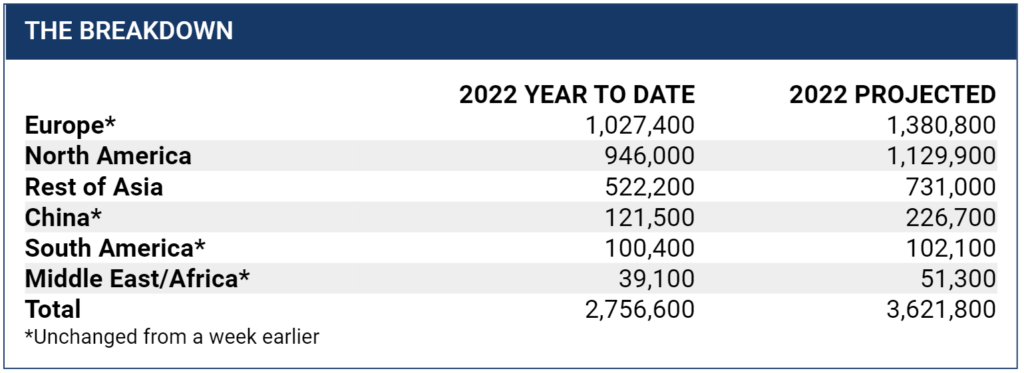
Relief on the way?
Last week, Bosch announced it will invest more than $3 billion in semiconductor production as it looks to develop a lasting solution to the chip shortage.
Chip Shortage Update 7/5/22
The forecast worsens as the chip shortage is expected to drag into 2023.
Auto plants in Europe and North America auto plants canceled another 104,000 vehicles from their production schedules because of chip shortages. North American production plants removed 36,000 vehicles from schedules this week. European plants removed 68,000 vehicles from production.
Industry analysts at AutoForecast Solutions now forecast a total of 167,000 vehicles will be permanently lost from production in 2022.
Automotive News reports that the chip shortage numbers can be misleading.
“Trimmed factory plans do not tell the whole story of the chip shortage at the moment. Last week, General Motors said in a regulatory filing that it had built 95,000 vehicles in the second quarter that were incomplete because of missing components. Most of the incomplete GM vehicles were produced in June.”
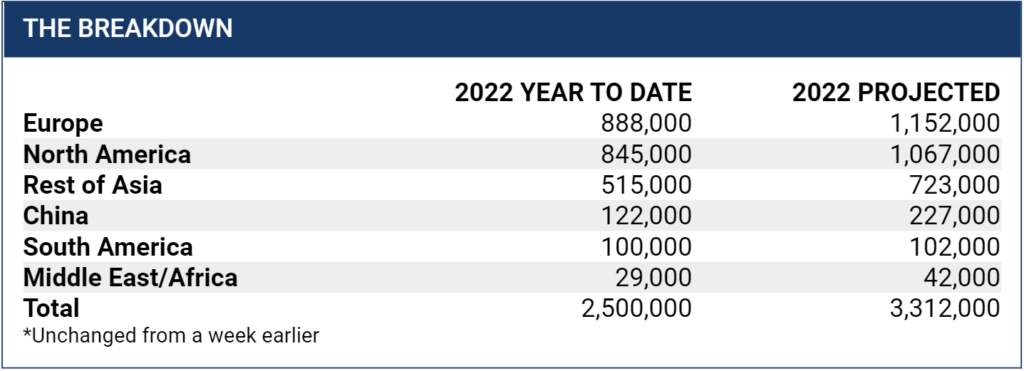
Chip Shortage Update 5/23/22
North American factories hit hard again; Expectations for 2022 worsening
An additional 87,500 vehicles were canceled from North American automaker’s production schedules last week. European factories lost another 4,200 units. This is a major loss for factories in North America, and the impacts will be felt in new car inventories in the months to come.
The year started out with forecasters holding on to a glimmer of hope, but that optimism is slipping away. It does not look like the semiconductor chip shortage will end in 2022, and it may extend deeper into 2023 than was previously expected.
Sam Fiorani, AutoForecast Solutions vice president of global vehicle forecasting, told Automotive News that the chip shortage is far from over. “Tackling the semiconductor shortage is a long-term problem because there is no expectation of fewer chips being used in vehicles as they become more complex. In the short term, however, the automotive industry continues to compete for limited fab space with other fields where more profitable chips are the norm. Expectations for a solution this year have faded and 2023 may not see a full recovery either.”
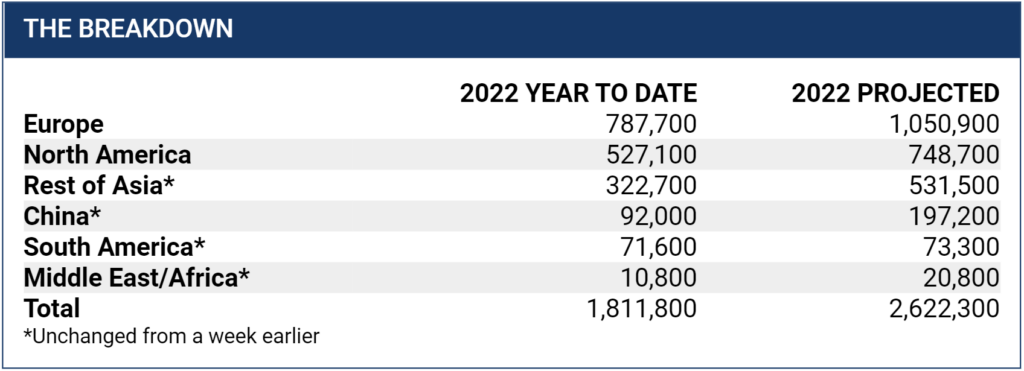
Chip Shortage Update 5/16/22
26,400 more vehicles lost; Asian automakers hit hardest
The chip shortage drags on, but there’s a glimmer of hope in the latest numbers from AutoForecast Solutions. For the first time in months, North American assembly plants did not add vehicles to their long list of production schedule cuts. Factories in Europe, China, South America, the Middle East and Africa also avoided making further cuts.
The newly announced 26,400 vehicle production cuts are from Asian factories (outside of China) that have been impacted by the latest COVID lockdowns that have affected supply chains in the region.
AutoForecast Solutions executive Sam Fiorani told Automotive News that the chip shortage is far from over. “The supply of automotive-grade semiconductors continues to hamper global output of trucks and passenger cars, even if the short-term losses do not seem to reflect this slowdown.”
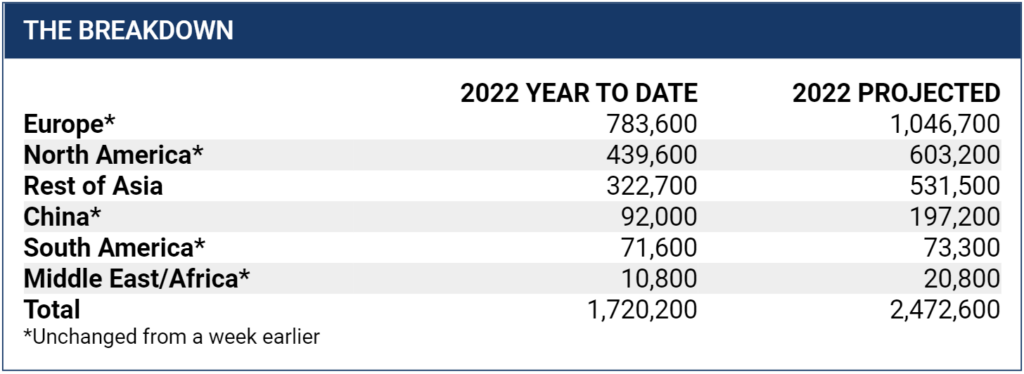
Chip Shortage Update 4/26/22
Another 87,500 vehicles removed from production schedules
The latest data from AutoForecast Solutions puts 2022’s total production cuts at 1.59 million vehicles, an increase of 259,000 since late March. In 2021, automakers were forced to cut 10.5 million vehicles from production as the semiconductor chip shortage worsened. With the latest 2022 figures, the total impact of the chip shortage has climbed to 12 million vehicles lost from production.
Of the 87,500 vehicles removed from production over the last week, North American factories were the hardest hit, with about 35,600 vehicles lost. Assembly plants in Asia (outside of China) lost 32,800 scheduled vehicles last week. European plants removed about 16,500 vehicles from their schedules, but the ongoing Ukraine crisis continues to loom over the market there.
Shanghai shutdown impacts chip production… again
The Washington Post reports that China’s output of semiconductor chips fell 4.2 percent in the first quarter in China compared to Q1 of 2021. Shanghai remains in lockdown over China’s zero-COVID policy. Shanghai and the surrounding area is a major hub of semiconductor production.
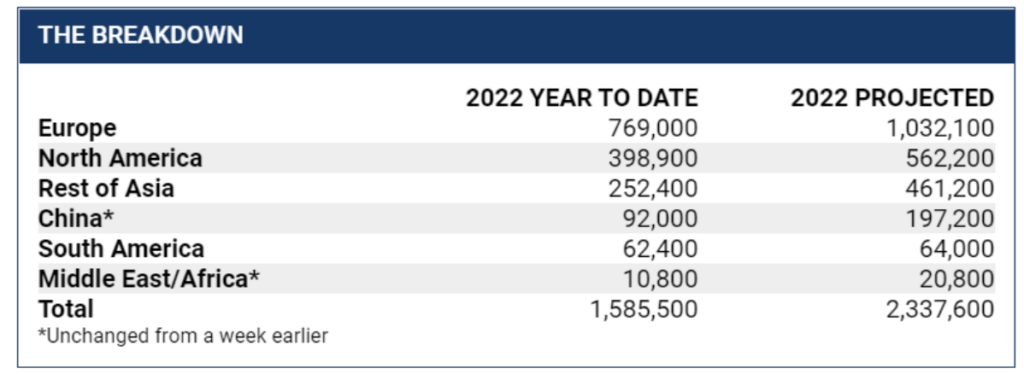
Chip Shortage Update 4/1/22
Both Ford and General Motors stop production in Michigan
The chip shortage has forced at least one of America’s two largest automakers to take factories offline next week. Ford is shuttering the Flat Rock Assembly Plant next week, and GM is shutting down production at the Lansing Grand River Plant. Ford makes the Mustang at Flat Rock, and GM’s Lansing Grand River facility makes the Cadillac CT4, Cadillac CT5 and Chevrolet Camaro.
Ford admits that the semiconductor chip shortage is to blame, but GM has not given any reasons for the shutdown. In 2021, Ford sold just 52,414 Mustangs in 2021, making it the worst sales year in decades for the Mustang. General Motors sold even fewer Camaro sports cars in 2021, with sales totaling just 21,893.
It looks like both automakers are rationing what few semiconductors they can get for their higher volume, higher margin models. If that’s their game plan, next week’s targeted cuts make sense. For perspective, Ford sold 726,000 F-Series trucks in 2021, and GM sold 530,000 Chevrolet Silverado trucks.
Automakers are expected to release Q1 sales numbers today. We’ll share the latest impacts of the chip shortage on auto sales once we have the data.
Chip Shortage Update 3/28/22
96,300 more vehicles were removed from production schedules
The chip shortage and worsening supply shortages resulted in nearly 100,000 more vehicles being eliminated from auto manufacturer’s production schedules. According to industry analysts at AutoForecast Solutions, about 1.25 million vehicles have been removed from factory schedules worldwide so far in 2022. Ongoing semiconductor chip shortages and supply constraints have raised 2022’s projected production losses to 2,001,700 vehicles worldwide.
European automakers have been hit the hardest in this latest round of cuts. In Europe, 79,100 cars and trucks were removed from factory schedules. Volkswagen Group has been hit particularly hard. VW just announced a delayed launch for the latest ID. model, the ID.5 electric crossover. In North America, 14,200 vehicles were cut.
In 2021, about 11 million vehicles were lost from production. Could this year’s losses approach what we saw last year? The next few months will be critical.
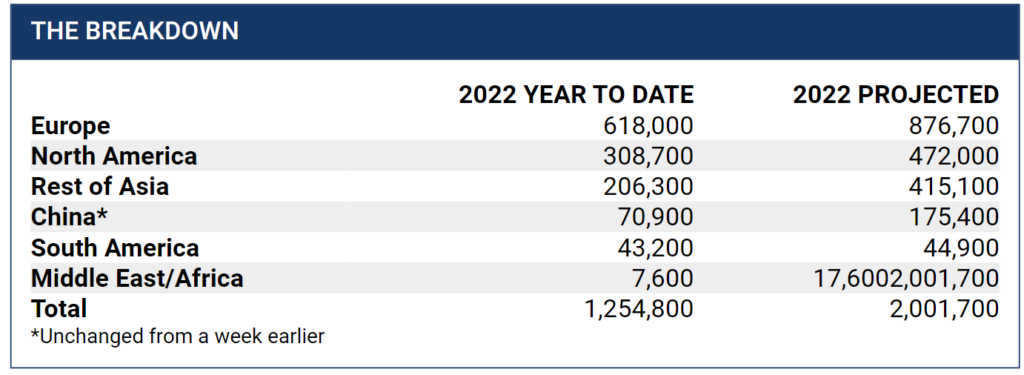
General Motors halts pickup truck production
The semiconductor chip shortage has forced GM to halt production of the Chevrolet Silverado and GMC Sierra during the weeks of April 4 and April 11. GM President Mark Reuss told CNBC that chip supplies were “getting a little better” but the crisis was not over. “We’re not through this, we’re doing the best we can.”
GM’s announcement of a production stop is particularly notable considering that the Sierra and Silverado are higher margin vehicles for the automaker. If these two money-making models are temporarily removed from production, the chip shortage may be worse than company executives make it seem.
Chip Shortage Update 3/21/22
The total vehicles removed from production in 2022 exceeds 1 million
Last week’s earthquake in Japan continues to send shockwaves through automotive supply chains. The quake, which struck along the Pacific Coast northeast of Tokyo, damaged infrastructure and forced several chip makers to suspend operations during clean up and repairs.
Now, AutoForecast Solutions upped their estimate to 1.2 million vehicles have been cut from global production this year because of the chip shortage. Just last week, the analysts estimated 929,500 vehicles removed from production. Newly announced production cuts from European and Asian automakers pushed the figure higher in the last few days.
Chip maker Renesas resumes full production this week
The earthquake on March 16 forced major chip maker Renesas to suspend production at three plants in Japan. Clean up is nearly complete, and Renesas intends to resume production as normal on Wednesday, March 23. Renesas supplies semiconductor chips to General Motors, Ford and Volkswagen, among others.
Total and projected vehicles removed from production in 2022
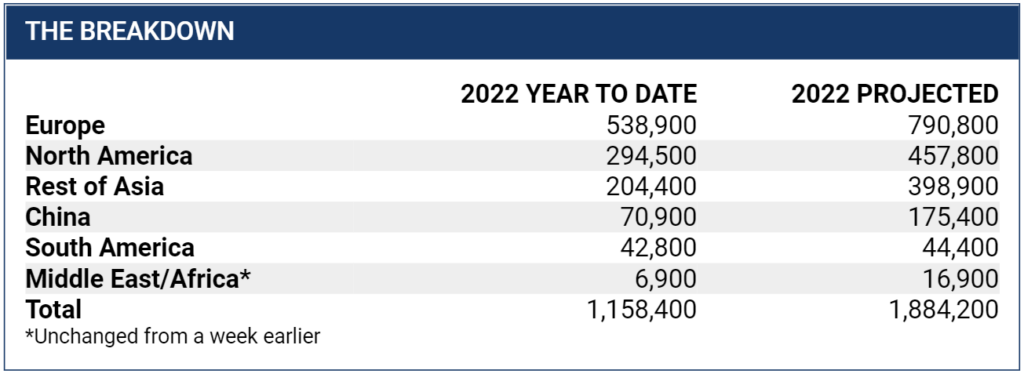
Chip Shortage Update 3/17/22
Ukraine war and worsening chip shortage could cut 2.6 million vehicles from production this year
Auto industry analysts at S&P Global Mobility significantly lowered their light vehicle production outlook, citing the “fragility of the world’s economy” and the automotive supply chains. The auto forecasters downgraded their 2022 and 2023 global light vehicle production forecast by 2.6 million units for both years, to 81.6 million for 2022 and 88.5 million units for 2023.
Their worst case scenario forecast shows possible reductions of up to 4 million units for 2022.
Europe is hit especially hard due to the supply chain reliance on both Russia and Ukraine. North American production was reduced by 480,000 units in 2022, and by 549,000 units for 2023.
In total, nearly 25 million units were removed from the S&P Global Mobility light vehicle production forecast between now and 2030.
The takeaway? As long as there’s war in Ukraine (and COVID shutdowns anywhere), there’s no end in sight to the car chip shortage.
Toyota cuts production further
After struggling to reach its goals of getting production back to near normal, the ongoing semiconductor chip shortage has forced Toyota to be more realistic. Toyota announced it has slashed April production targets by 150,000 vehicles to a total of 750,000.
In the fiscal first quarter of 2022, Toyota estimates that production will average about 800,000 vehicles a month. That figure is revised down from the previous forecast of 900,000 vehicles or more.
“Up until now, we have conducted recovery production with tremendous efforts from the various relevant parties,” Toyota said. “However, due to the parts shortage, we have had to make repeated last-minute adjustments to production plans, and this has imposed considerable burdens on production sites including those of suppliers.”
Seeing (finally) that unusual times call for more flexibility, Toyota will review production plans on a monthly and three-month basis. Toyota also cautioned that future production numbers may need to be lowered further.
An earthquake has closed three semiconductor plants
Japanese manufacturer Renesas has suspended chip production at three plants in Japan after a 7.4-magnitude quake rattled the Pacific Ocean floor just off the coast.
Renesas does not know when production might resume at two of the factories. Production has resumed at the third. The plants make chips for automotive, industrial and electrical use. This includes the production of chips for AC-DC electrical power conversion, which is essential for electric vehicle charging.
Chip Shortage Update 3/14/22
Where do we start? It’s not looking good. A COVID spike in Shenzhen, China has shuttered Foxconn’s facilities, including those that produce semiconductor chips for the global automotive industry. Shenzhen is home to hundreds of major tech manufacturers, so the COVID lockdown is sure to impact everything from heated seats in cars to cell phone makers.
The chip shortage is getting worse in 2022. Just a week after new car inventory officially hit a new record low, AutoForecast Solutions announced that automakers’ chip-related production cuts surged 42 percent from a previous estimate.
Automotive News reports that 929,500 vehicles have been canceled from global production so far this year. That’s up 42% from the prior estimate of 656,200. In 2022, 1,655,300 vehicles are expected to be removed from global production schedules. About 11,000,000 vehicles were lost in 2021 because of the chip shortage. Is that where we’re headed, again?
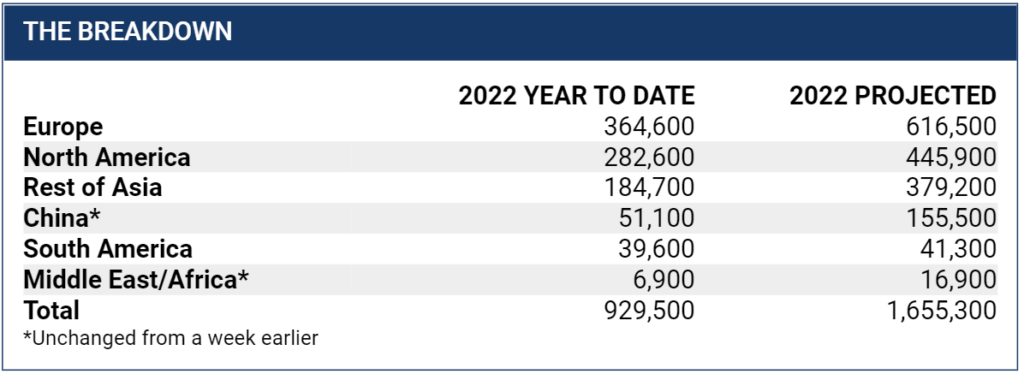
Toyota will reduce output by 20 percent at its Japanese plan in April, May and June due to the parts shortages hitting Japanese automakers particularly hard.
Tesla’s tight control over its supply chain has cushioned the all-electric automaker from the worst of the chip shortage’s impacts. Many of Tesla’s vehicle components are designed and made in-house. Still, Tesla has been impacted by the 2022 chip shortage.
CEO Elon Musk has noted that Tesla has substituted their typical semiconductors with other types of compatible chips. The Tesla Cybertruck was delayed yet again, and the Roadster remains elusive. Some Tesla components have gone missing as a result of supply chain woes, and some cars have even reached customers without USB ports. However, the automaker continues to make record deliveries, even as competitors struggle severely.
Tesla’s chip shortage strengths recently propelled its sales to surpass BMW in North America. It’s possible that the longer the chip shortage drags on, the stronger Tesla’s grip on the luxury segment will become.
Chip Shortage Update 2/14/22
“North America chip cuts more than double” — that’s the headline from Automotive News today. So far in 2022, AutoForecast Solutions has increased their projection of vehicles lost in production due to the chip shortage by 63%, from 767,700 to 1,253,100. At the beginning of this year we were cautiously optimistic that the chip shortage was behind us. Data from industry leaders like AutoForecast Solutions suggested that the worst was behind us.
Sadly, that’s not the case. In just the first six weeks of 2022 over 500,000 vehicles have been taken out of production because of the semiconductor shortage. North America has been hit the hardest, with 221,000 vehicles already having been taken out of production.
| Region | February 2022 | Total 2022 projected |
| Europe | 143,000 | 394,900 |
| South America | 37,500 | 39,100 |
| North America | 221,500 | 384,700 |
| China* | 51,100 | 155,500 |
| Rest of Asia* | 69,200 | 263,700 |
| Middle East/ Africa* | 5,000 | 15,100 |
| Total | 527,400 | 1,253,100 |
Ford and Toyota are struggling mightily. Ford announced they will cut vehicle output from their plants in Ohio and Missouri this week, as well as reducing shifts at a number of others because of the lack of microchips. Toyota recently revised their annual operating profit projections after profits tumbled 21% in the previous quarter. Subaru and Mazda are also struggling to produce vehicles. All Japanese automakers have found themselves in a tough position.
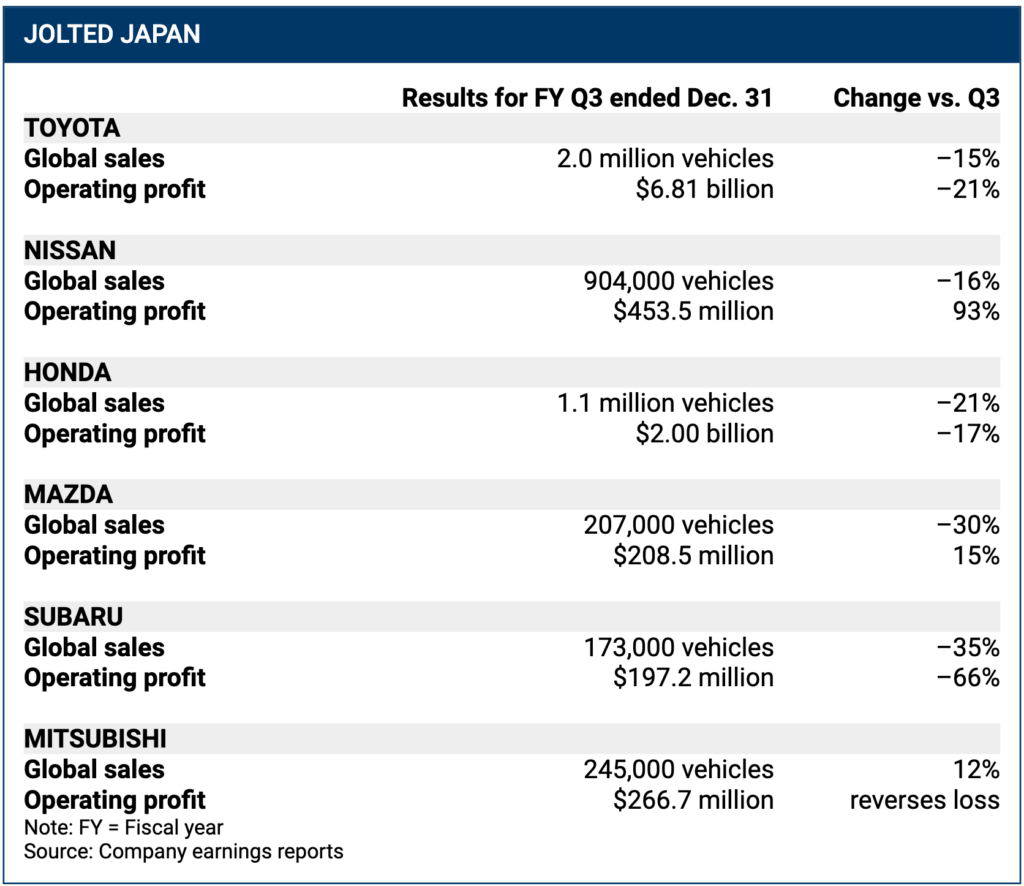
Chip Shortage Update 2/7/22
We’ve seen this before, yet many thought we’d have moved past it by now. The semiconductor chip shortage has impacted sales yet again. Here’s the latest from CarEdge:
- Dealer inventory is down 61%
- January vehicle deliveries were down 9%
- Transaction prices now average $44,905
- 370,500 units have been cut from production in 2022
- New estimates raise expected cuts in 2022 to exceed 1 million cars
In 2021, more than 10 million vehicles were cancelled from production schedules due to supply constraints. New data from AutoForecast Solutions reveals the prolonged impact of the chip shortage in 2022. Globally, the number of vehicles cancelled from production schedules increased 61% from a week earlier. With the revamped estimates creeping ever higher, AFS now projects that more than 1 million vehicles will be cut from factory production schedules in 2022.
What’s the basis of these dismal forecasts? Already in 2022, 370,500 have been officially axed from production. Analysts still think the chip shortage will improve as the year progresses, but the surprisingly higher impacts thus far have lowered optimism across the board.
Silver Lining?
When seasonally adjusted, Thomas King from J.D. Power noted that January sales were actually the healthiest they’ve been since June of 2021. If anything, this highlights just how bad the chip shortage has gotten, and how low our expectations have fallen. Automotive News reports that the seasonally adjusted annualized rate (SAAR) of sales in January was actually on the high-end of forecasts from industry analysts like J.D. Power, Cox, TrueCar and LMC Automotive.
Chip Shortage Update 1/31/22
“Another big jump in 2022 estimated production cuts” — that’s the headline from Automotive News. It’s as if we’re watching a re-run of the same movie. Initial estimates for 2022 were that the chip shortage would abate, and that near-normal production would occur. Instead, we are witnessing what we saw last year; automakers are cutting vehicle production drastically week-over-week as a result of insufficient parts.
Let’s look at the latest data from AutoForecast Solutions for vehicle taken out of production in January, and projected for the entirety of 2022.
| Region | January 2022 | Total 2022 projected |
| Europe | 33,000 | 271,500 |
| South America | 17,900 | 19,600 |
| North America | 71,700 | 239,200 |
| China* | 51,100 | 155,500 |
| Rest of Asia* | 55,800 | 250,300 |
| Middle East/ Africa* | 1,300 | 11,300 |
| Total | 230,800 | 947,400 |
Nearly a quarter of a million vehicles were lost in January. At this rate we would expect to see ~3m vehicles lost to the chip shortage in 2022. Last year we lost nearly 11m.
The first projection for 2022 estimated that globally the chip shortage would take 767,700 vehicles out of production. That number has increased 23% in January.
Chip Shortage Update 1/24/22
The headline on Automotive News this morning reads, “The chip shortage is back for Year 2” … Sadly, we have bad news to deliver this week. So far this year 187,200 vehicles have been taken out of production. An increase of 38,000 vehicles week-over-week. That number is significantly down from the prior week.
| Region | 2022 YEAR TO DATE | LAST WEEK | CHANGE |
| Europe | 59,600 | 70,800 | -11,200 |
| South America | 48,300 | 41,500 | 6,800 |
| North America | 36,000 | 36,900 | -900 |
| China* | 26,900 | 0 | 26,900 |
| Rest of Asia* | 16,400 | 0 | 16,400 |
| Middle East/ Africa* | 0 | 0 | 0 |
| Total | 187,200 | 149,200 | 38,000 |
Where we saw a more meaningful increase was in the annual projection. That increased to over 900,000 vehicles that are expected to be lost this year due to the chip shortage. Frustratingly, AutoForecast solutions increased the North America projection by over 100,000 vehicles, while reducing Europe and Asia signifigantly.
| Region | 2022 PROJECTED | LAST WEEK | CHANGE |
| Europe | 220,400 | 331,000 | -110,600 |
| South America | 210,300 | 43,200 | 167,100 |
| North America | 291,700 | 186,000 | 105,700 |
| China* | 138,300 | 108,100 | 30,200 |
| Rest of Asia* | 34,000 | 156,600 | -122,600 |
| Middle East/ Africa* | 10,000 | 8,000 | 2,000 |
| Total | 904,700 | 832,800 | 71,900 |
Chip Shortage Update 1/17/22
Another week, another chip shortage update. Unfortunately, the projections we received from AutoForecast Solutions paint a more realistic, albeit worse chip shortage scenario than just seven days prior.
This past week 101,900 vehicles were taken out of production, up from 47,300 the prior week.
| Region | 2022 YEAR TO DATE | LAST WEEK | CHANGE |
| Europe | 70,800 | 23,600 | 47,200 |
| South America | 41,500 | 13,800 | 27,700 |
| North America | 36,900 | 9,800 | 27,100 |
| China* | 0 | 0 | 0 |
| Rest of Asia* | 0 | 0 | 0 |
| Middle East/ Africa* | 0 | 0 | 0 |
| Total | 149,200 | 47,300 | 101,900 |
AutoForecast Solutions not only tracks the actual number of vehicles lost to production each week from the chip shortage, they also update a projection for the total number of vehicles they anticipate being lost from production for the entire year. Interestingly, even thought 101,900 vehicles were lost to production this past week, AutoForecast Solutions only increased their projection for the entire year by 65,100 units.
| Region | 2022 PROJECTED | LAST WEEK | CHANGE |
| Europe | 331,000 | 280,800 | 50,200 |
| South America | 43,200 | 31,400 | 11,800 |
| North America | 186,000 | 174,300 | 11,700 |
| China* | 108,100 | 108,200 | -100 |
| Rest of Asia* | 156,600 | 163,000 | -6,400 |
| Middle East/ Africa* | 8,000 | 10,000 | -2,000 |
| Total | 832,800 | 767,700 | 65,100 |
The only justification for this would be that they think the actual losses each week will decline from here on out, or more likely, they’ll simply continue to increase their total projected losses. We saw this last year when their projections went from 500,000 to more than 11 million over the course of the year.
We did get bad news this week from Volkswagen and Toyota. Both companies announced that their plants in Tianjin, China were closed due to pandemic reasons. Toyota annually produces 620,000 vehicles at this production facility, so this will certainly be a story worth keeping our eyes on.
Chip Shortage Update 1/10/22
The chip shortage that has plagued automakers for well over a year now appears to be abating. In December of 2021 we measured the slowest increases in expected losses of production as a result of the chip shortage we had all year (around 20,000 vehicles). For the entire year automakers globally lost 10.2 million vehicles from production because of the chip shortage.
Asian auto plants were the hardest hit, with more than 3.6 million vehicles taken out of production. North America was second with nearly 3.1 million vehicles lost, and Europe was third, with approximately 3 million vehicles lost.
What have we seen so far in 2022? Data from AutoForecast Solutions (which is the most consistently updated and reported on data source) shows us that production cuts so far have been relatively small.
| Region | 2022 YEAR TO DATE | 2022 PROJECTED |
| North America | 9,800 | 174,300 |
| Europe | 23,600 | 280,800 |
| China | 0 | 108,200 |
| Rest of Asia | 0 | 163,000 |
| South America | 13,800 | 31,400 |
| Middle East/Africa | 0 | 10,000 |
| Total | 47,300 | 767,700 |
After the industry cut 10.2 million vehicles in 2021, AutoForecast Solutions only projects 767,700 vehicles lost this year. That’s fascinating, because another well respected firm, Boston Consulting Group published a report on the semiconductor shortage and its impacts on the auto industry just three weeks ago.
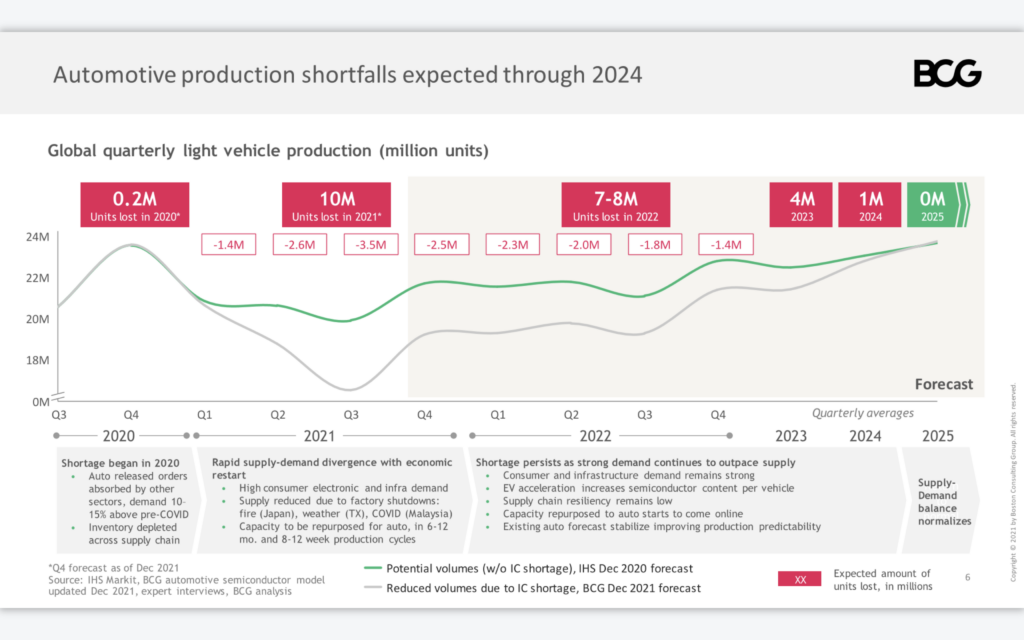
As you can see, BCG expects automakers to lose 7-8 million units of production this year, as compared to the 10 million lost last year. However the more recent data from AutoForecast Solutions tells a completely different story (less than 1 million vehicles lost).
Who’s right? It’s impossible to know. That being said, the headlines from Toyota and other automakers does make it seem like production is ramping back up. We’ll continue to update this page weekly as we get more data on the ongoing chip and car shortage. Be sure to subscribe to our newsletter to get updates.
Do electric vehicles require more chips?
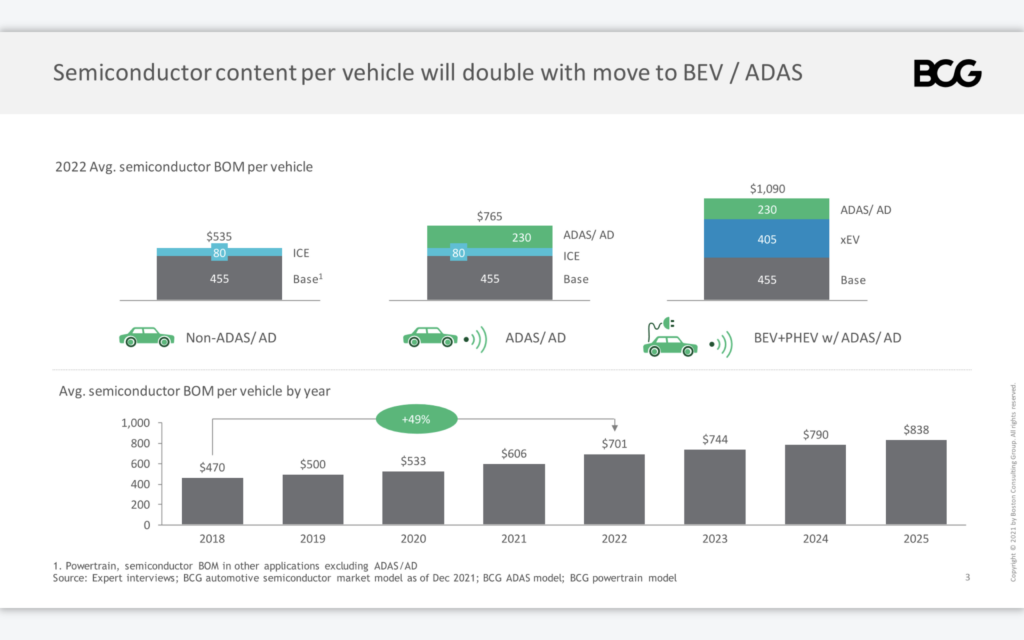
Within the report BCG published there is fascinating data on the cost of semiconductors per vehicle manufactured. BOM stands for “bill of materials”. ADAS is advanced driver assistance systems, and EV stands for electric vehicle.
As you can, a “basic” vehicle with a combustion engine and no ADAS has a total cost of $535 for semiconductors. A combustion engine vehicle with ADAS costs $765, and an EV with ADAS costs nearly $1,100.
The cost of semiconductors, and the number of semiconductors within a vehicle continues to increase as more functionality and features make their way into our cars.
Chip Shortage Update 12/20/21
It appears that the worst of the 2021 chip shortage is behind us (at least for the automotive industry that is). Data provided by AutoForecast Solutions tracks the weekly ebbs and flows of chip related production cuts, and for the first time since starting their weekly projections, the worst case scenario for vehicles that will be cut from manufacturer’s production schedules this year because of the microchip crisis declined by 20,000 units.
Two weeks ago, for the first time in over a year, the weekly projection for vehicles lost in production due to the chip shortage did not increase at all. This week it declined. This is great news!
This week, for the third week in a row, the projection for vehicles lost due to the chip shortage for North American factories, actually decreased week-over-week!
This page will be updated as new information becomes available regarding the semiconductor chip shortage of 2021.
Are we nearing the end of the chip shortage?
Automakers have taken a major hit as a result of the chip shortage. profits at Subaru, GM, Ford, and nearly every other major OEM have been down significantly in 2021. That being said, starting in the November, each company began signaling that they were through the worst of the chip shortage and that things would slowly start to get better.
Each week we track data provided by AutoForecast Solutions on the chip shortage. Their data shows a plateau happening.
| Date | projected # of vehicles lost | Change from prior week |
| 9/13 | 9,436,000 | – |
| 9/20 | 9,574,000 | 138,000 |
| 9/27 | 10,150,000 | 576,000 |
| 10/4 | 10,305,000 | 155,000 |
| 10/11 | 10,561,000 | 256,000 |
| 10/18 | 10,842,000 | 281,000 |
| 10/25 | 10,943,000 | 101,000 |
| 11/1 | 10,983,035 | 40,035 |
| 11/8 | 11,002,000 | 18,965 |
| 11/15 | 11,263,000 | 261,000 |
| 11/22 | 11,285,000 | 22,000 |
| 11/29 | 11,285,000 | 0 |
| 12/6 | 11,323,980 | 38,980 |
| 12/13 | 11,325,198 | 1,218 |
| 12/20 | 11,309,400 | -15,798 |
The table above shows the projected number of vehicles lost because of the chip shortage. Each week AutoForecast Solutions updates this number to reflect the current state of the industry. As you can see the rate at which they have been increasing the total number of lost vehicles is slowing down. This week the projections even decreased.
It was a little over a month ago that the projection increased by 261,000 vehicles globally. Since then, we’ve seen a plateau. It appears that the worst-case scenario for the chip shortage is behind us.
What impact has the chip shortage had on new car supply?

Chip Shortage Update 10/26/21
Every automaker has drastically cut back production of their new vehicles as a result of the chip shortage. “Days supply” is an industry metric that is used to measure how much inventory a dealership has in stock relative to demand. Each manufacturer is experiencing a dwindling days supply of inventory. This means dealerships are less likely to discount or negotiate.
| Manufacturer | Days Supply (April) | Days Supply (May) | Days Supply (Oct) | Days Supply (Nov) |
|---|---|---|---|---|
| Ford | 45 | 34 | 38 | 37 |
| Lincoln | 56 | 36 | 30 | 29 |
| Acura | 53 | 50 | 19 | 19 |
| Honda | 56 | 43 | 19 | 17 |
| Genesis | 74 | 57 | 40 | 33 |
| Hyundai | 49 | 41 | 12 | 11 |
| Kia | 34 | 30 | 15 | 12 |
| Mazda | 44 | 38 | 13 | 10 |
| Subaru | 24 | 16 | 5 | 4 |
| Toyota | 26 | 23 | 17 | 21 |
| Volvo | 55 | 45 | 30 | 27 |
With a shortage of new vehicles, we have seen skyrocketing used car prices. Wholesale used car vehicle prices have increased nearly 40% so far in 2021. As of October, retail used car prices are up nearly 30%
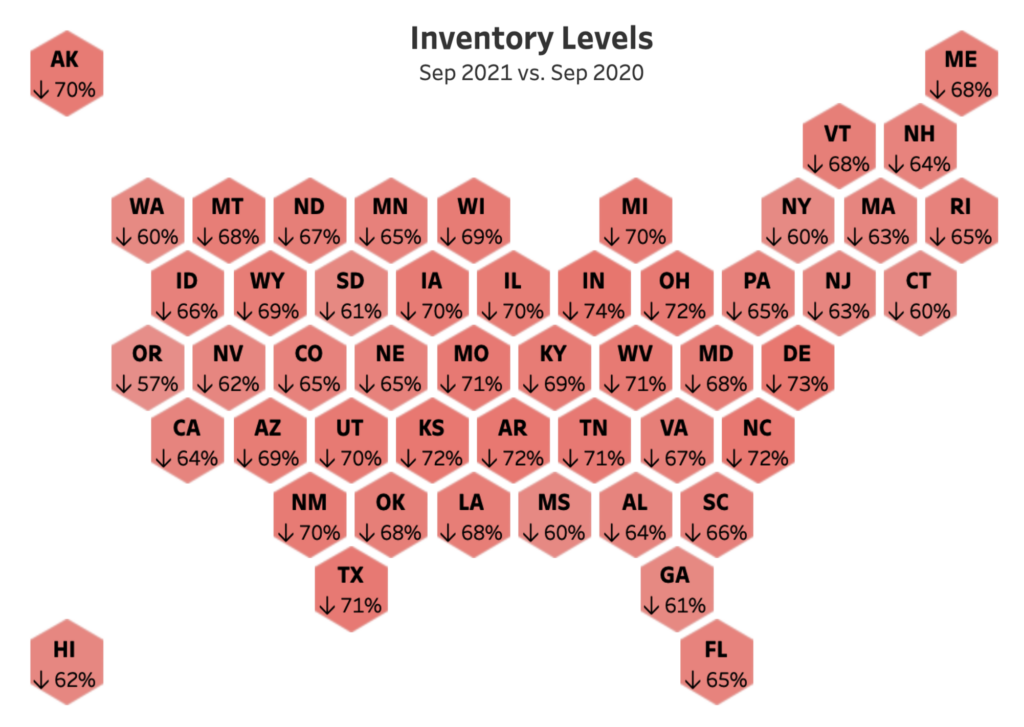
Inventory levels are down across all 50 states. There are some regions of the country that have more inventory than others, and some brands have weathered the storm better than their peers. We created a complete guide on how inventory levels have changed state-by-state to help you navigate finding inventory near you. If you do buy a car out of state, be sure to reference this guide for buying a car from a different state.
Buying a car in this market? Let us help you get a fair deal!
So far automakers have lost nearly 10 million vehicles as a result of the chip shortage. The expectation is that the total loss from the chip shortage will reach 11 million by the end of 2021.
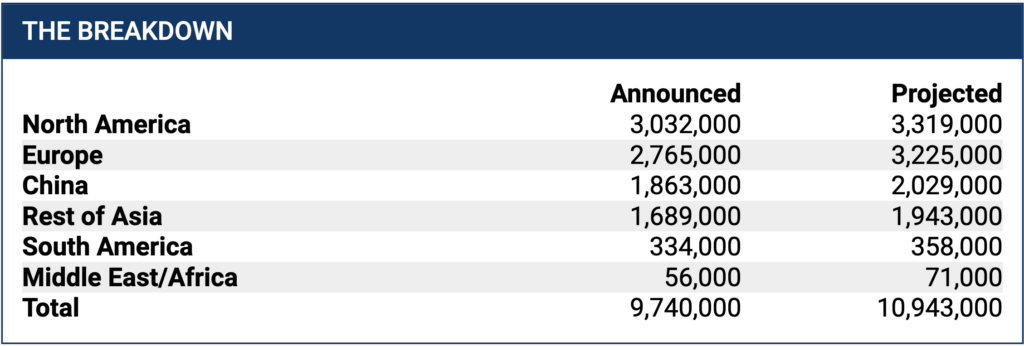
Chip Shortage Update 5/26/21
What manufacturers are cutting back production?
It is estimated that up to 5 million new vehicles will not be produced in 2021 as a result of the chip shortage. Current lost production by manufacturer is below.
| Manufacturer | Lost production |
|---|---|
| Ford | 324,616 |
| General Motors | 277,966 |
| Stellantis | 252,193 |
| Subaru | 45,272 |
| Volkswagen | 45,215 |
| Honda | 42,951 |
| Nissan | 41,928 |
| Toyota | 23,670 |
| Tesla | 6,418 |
| Mazda | 6,133 |
| COMPAS | 4,200 |
| Hyundai | 2,548 |
| Volvo | 1,287 |
Brands impacted so far:
- Ford – Especially their new 2021 Ford F-150
- Toyota – Especially their 2021 Tundra
- Nissan
- Honda
- Mazda
- Subaru
- Stellantis which includes
- Chrysler
- Dodge
- Fiat
- VW Group which includes
- VW
- Audi
- Porsche
Kia announced at NADA that they will not be limiting production as a result of the chip shortage.
What impact is the chip shortage having on vehicle prices?
From Black Book, “We are hearing more each week in the market about reduced inventory in the pipeline for Q1.With new car manufacturing facing supply chain struggles due to the microchip shortage, as well as a possible additional round of stimulus, the expectation is that pricing will remain strong throughout Q1 and into Q2.”
Other data from Black Book shows a recent increase in wholesale used car prices. As a result of limited new car supply we are seeing used car prices increase as well.
Chip Shortage Update 5/26/21
When will the chip shortage end?
In a recent interview with Jean-Marc Chery, the CEO of STMicroelectronics for Automotive News, the executive was asked this very question. His response, “Our forecast is that we should start seeing an improvement to the overall situation in the first quarter of 2022.”
No one knows for certain, but many representatives from the largest semiconductor companies have provided guidance that production increases will not meet demand until Q3 of 2021 at the earliest.
From Reuters, “TSMC, the world’s top contract chipmaker, said it was “expediting” auto-related products through its wafer fabs and reallocating wafer capacity. It now expects to lift capital spending on the production and development of advanced chips to between $25-28 billion this year, as much as 60% higher than the amount it spent in 2020.”
Can I still get a good car deal?
Yes. The tactics used before the global chip shortage to negotiate a good car deal still apply today. Will you be able to purchase a vehicle at a similar discount compared to a month ago? No. Will you be able to negotiate a fair deal based on the current market conditions? Yes.
Is now a good time to sell my car?
Yes. Used car wholesale prices are just beginning to climb after 20 weeks of declines. If you have a vehicle that you are looking to sell we strongly recommend you get a quote from Carvana, Vroom, and CarMax. Take the highest quote you receive to your local dealership and ask them to beat it. If they don’t, sell it to the highest bidder.
We anticipate that wholesale used car prices will continue to rise for the coming weeks and months. With that in mind, you may want to get a quote today for your vehicle and then wait ~4 weeks to see if it has appreciated more.
My lease is coming due, should I buy it out?
Most likely yes. If your lease is coming due over the following 2-4 months it is likely that you will be in the rare position of having “positive equity” in your vehicle. Because used car prices are increasing, it may make sense to purchase your vehicle at the residual value set 3 years ago.
Chip Shortage Update 3/3/21
One month after we first reported on AutoForecast Solutions projected decrease in new vehicle supply, not much has changed. Many auto manufacturers are still continuing to face supply shortfalls (not enough semiconductors) to produce all of their inventory. Ford recently increased their production cuts, directly impacting the Ford Edge and Lincoln Nautilus. The total expected shortfall in new vehicles for 2021 for all automakers is projected at 1.6 million units.
General Motors announced on 3/3/21 that “it was further extending production cuts at three North American plants and adding a fourth to the list of factories hit by the global semiconductor chip shortage.”
“The extended cuts do not change GM’s forecast last month that the shortage could shave up to $2 billion from this year’s earnings. GM CFO Paul Jacobson subsequently said chip supplies should return to normal rates by the second half of the year and he was confident the profit hit would not worsen.”
Update 2/15/21: Lost production as a result of the ongoing chip shortage has totaled 680,350 vehicles. AutoForecast Solutions has increased their forecast from 1 million to 1.3 million vehicles that will not be produced in 2021 as a result of semiconductor shortage.
So far lost production is approximately 564,000 units with the prospect of almost 1 million total vehicles not being produced this year because of the existing and ongoing semiconductor chip shortage. AutoForecast Solutions













Hey guys want to tank you for all you do!
I do have a question and don’t know if this is the spot I post it to? I have never seen this addressed, but maybe I missed it.
I am looking for a 2015 toyota venza limited AWD. I would love a 2016 venza redwood but it’s the last venza made by Toyota and it was only made in Canada. I’m from Illinois and when I do find a 2015 limited with low miles they always seem to be on the west coast and no one there wants to deal with it. How do I go about getting one of the 2 cars ?
Thank you for your time,
Debbie Arvio
When you have to look far and wide for the exact model etc, your best bets are national chains, such as carvana and carmax. You will pay shipping, of course, but they make the entire process easier than doing it all on your own.
My NY registration expires today, 3/21/21. I moved to Ct. Can I sell my car in Ct after this expiration date?
would it be better to wait till next year to buy a brand new car?
What if the new 2021 vehicle you want is not a popular model (and not an SUV/truck), rumored to be updated soon and the dealer stock is limited because of these two factors?
I’m looking at a car recently on the lot (past couple of weeks) where some of the same model are on the lot for over 100 days. The Market Price Report doesn’t work for this make either, since it seems like the new cars for the brand are consistently listed at MSRP per the manufacturer’s guidance.
How should I approach this type of deal?
As always we recommend requesting the out the door price and negotiating from there!
Would increased prices also affect a factory order that’s negotiated down to the invoice price? My lease ends in September and my plan was to factory order in July
In 2018 I bought a new Honda Civic EX for $20,250. Yesterday the dealership bought it back for $19,531. I’m loving this chip shortage!
What is the best way to negotiate the price of a new fully loaded with the prestige package ($8200) Genesis G80 2.5, wait until 2022? I had read that the best price to shoot for is to add 3% over dealer invoice because the dealer would make $1600 over what the dealer acquired the car for plus the manufacturer still will be paying the dealer 3% in holdback fees (I googled what the holdback is for Genesis and I saw 3%). What do you think of using a invoice price plus $1000. They say no but I bring up the 3% holdback fee. So what do you say about this tactic?
John, please be sure to ask your question in the CarEdge Community: https://community.CarEdgemember.com/home
I was just at a local Hyundai Dealership and they have “Two” window stickers on their cars. One is the original manufacturer window sticker with the MSRP and a second one is on the front windshield adding $2,999.99 to the MSRP.
The salesperson told me the was increase was put on the vehicle by the manufacturer due to the vehicle shortage. I’m calling this a Dealership Rip-Off!!!
Doug, can you take a photo and share that with us? [email protected] is my email. Thanks, that would be super helpful.
Are these production cuts relative to 2019-level production targets or is it relative to prior year production targets? In other words, is the 1.5M cut from production YTD in April 2022 in addition to the lower production targets in 2021 due to cuts that happened in that year? Or should we be intrepetting production targets as unchanged therefore saying that we are much, much, better off than we were in 2021?